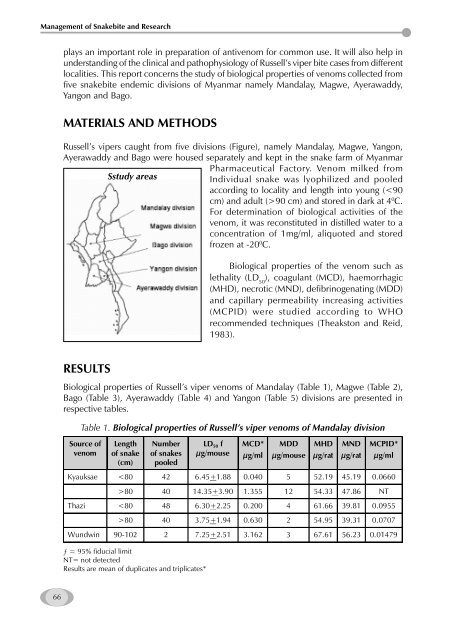Management of Snakebite and Research Management of Snakebite ...
Management of Snakebite and Research Management of Snakebite ...
Management of Snakebite and Research Management of Snakebite ...
Create successful ePaper yourself
Turn your PDF publications into a flip-book with our unique Google optimized e-Paper software.
<strong>Management</strong> <strong>of</strong> <strong>Snakebite</strong> <strong>and</strong> <strong>Research</strong><br />
66<br />
plays an important role in preparation <strong>of</strong> antivenom for common use. It will also help in<br />
underst<strong>and</strong>ing <strong>of</strong> the clinical <strong>and</strong> pathophysiology <strong>of</strong> Russell’s viper bite cases from different<br />
localities. This report concerns the study <strong>of</strong> biological properties <strong>of</strong> venoms collected from<br />
five snakebite endemic divisions <strong>of</strong> Myanmar namely M<strong>and</strong>alay, Magwe, Ayerawaddy,<br />
Yangon <strong>and</strong> Bago.<br />
MATERIALS AND METHODS<br />
Russell’s vipers caught from five divisions (Figure), namely M<strong>and</strong>alay, Magwe, Yangon,<br />
Ayerawaddy <strong>and</strong> Bago were housed separately <strong>and</strong> kept in the snake farm <strong>of</strong> Myanmar<br />
Pharmaceutical Factory. Venom milked from<br />
Individual snake was lyophilized <strong>and</strong> pooled<br />
according to locality <strong>and</strong> length into young (90 cm) <strong>and</strong> stored in dark at 40C. For determination <strong>of</strong> biological activities <strong>of</strong> the<br />
venom, it was reconstituted in distilled water to a<br />
concentration <strong>of</strong> 1mg/ml, aliquoted <strong>and</strong> stored<br />
frozen at -200 Sstudy areas<br />
C.<br />
RESULTS<br />
Biological properties <strong>of</strong> the venom such as<br />
lethality (LD 50 ), coagulant (MCD), haemorrhagic<br />
(MHD), necrotic (MND), defibrinogenating (MDD)<br />
<strong>and</strong> capillary permeability increasing activities<br />
(MCPID) were studied according to WHO<br />
recommended techniques (Theakston <strong>and</strong> Reid,<br />
1983).<br />
Biological properties <strong>of</strong> Russell’s viper venoms <strong>of</strong> M<strong>and</strong>alay (Table 1), Magwe (Table 2),<br />
Bago (Table 3), Ayerawaddy (Table 4) <strong>and</strong> Yangon (Table 5) divisions are presented in<br />
respective tables.<br />
Table 1. Biological properties <strong>of</strong> Russell’s viper venoms <strong>of</strong> M<strong>and</strong>alay division<br />
Source <strong>of</strong><br />
venom<br />
Length<br />
<strong>of</strong> snake<br />
(cm)<br />
Number<br />
<strong>of</strong> snakes<br />
pooled<br />
LD 50 f<br />
µg/mouse<br />
MCD*<br />
µg/ml<br />
MDD<br />
µg/mouse<br />
MHD<br />
µg/rat<br />
MND<br />
µg/rat<br />
MCPID*<br />
µg/ml<br />
Kyauksae 80 40 14.35+3.90 1.355 12 54.33 47.86 NT<br />
Thazi 80 40 3.75+1.94 0.630 2 54.95 39.31 0.0707<br />
Wundwin 90-102 2 7.25+2.51 3.162 3 67.61 56.23 0.01479<br />
ƒ = 95% fiducial limit<br />
NT= not detected<br />
Results are mean <strong>of</strong> duplicates <strong>and</strong> triplicates*









